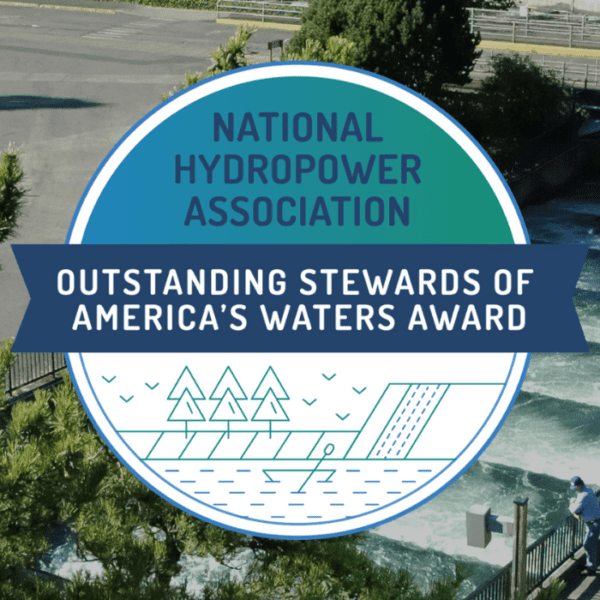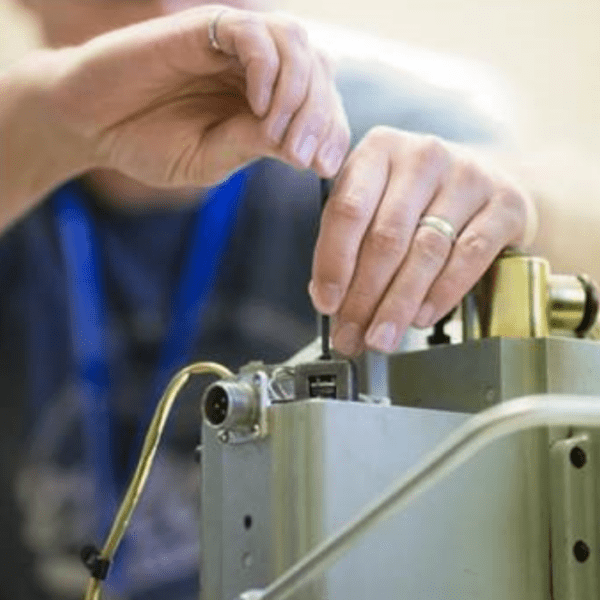Idaho Power Company’s new hatchery will release 2,500 juvenile white sturgeon into the Snake River this spring using naturally fertilized eggs. The goal? Sustain healthy sturgeon populations and offset habitat disruptions by the utility’s hydro operations.
Completed in 2021, the Niagara Springs Sturgeon Hatchery is Idaho’s first sturgeon hatchery of its kind. As this brief video shows, the hatchery was uniquely designed to hatch and rear naturally spawned white sturgeon eggs, known as repatriation.
The 3,500-square-foot facility is a culmination of a partnership between Idaho Power, the Idaho Department of Fish and Game, and the College of Southern Idaho. The hatchery is part of the White Sturgeon Conservation Aquaculture Plan to increase white sturgeon population in Snake River reaches where natural production is low and conserve patterns of population structure and genetic diversity unique to the area.
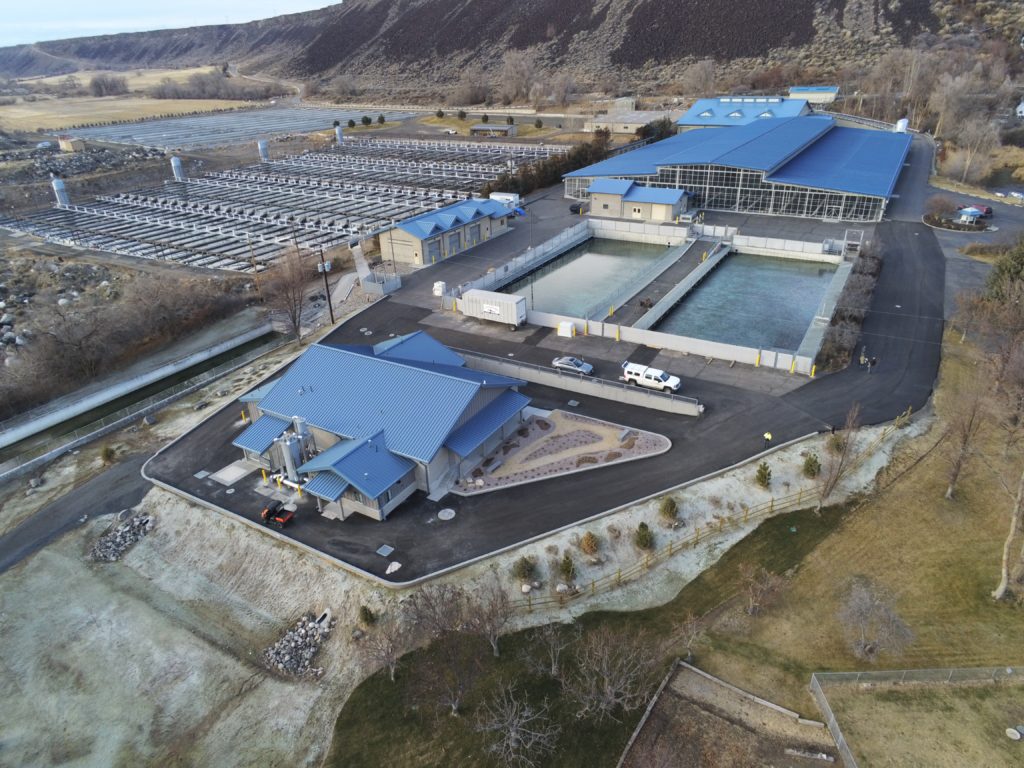
Idaho Power received a 2021 Outstanding Stewards of America’s Waters award from the National Hydropower Association (NHA), for its work on this unique hatchery.
THE DEEP DIVE: THE PROBLEM AND THE SOLUTION
“In several reaches of the Snake River in southern Idaho, sturgeon don’t spawn successfully or consistently enough to support healthy populations and robust fisheries, despite releasing eggs each spring,” said State Fisheries Manager Joe Kozfkay, with Idaho Fish and Game.
According to Idaho Power, a significant factor is a fragmented habitat into river reaches separated by dams, since white sturgeon require large stretches of diverse river habitats to complete their full life cycle and reproduce. Only one of the river segments has the full complement of habitat requirements to support natural production. Even in that reach, reproductive success that leads to recruiting young fish is infrequent and depends on high flows and suitable water temperatures.
Developing the Snake River to support hydroelectricity, irrigated agriculture, and growing municipalities has fragmented the sturgeon’s habitats, changed seasonal flow patterns, and increased sediments and nutrients flowing into the river. These river changes have affected the ability of some white sturgeon populations to be naturally sustained. Although thousands of eggs are deposited in the Snake River each spring during the white sturgeon spawning period, it takes the correct combination of river flows, water temperatures, and habitats for spawning to be successful. In many years, very few eggs survive and develop into young sturgeon.
Options are limited to rebuild the white sturgeon population in the Middle Snake River. To build populations, young fish recruitment into all reaches needs to occur more frequently than natural conditions provide. Adult white sturgeon size limits the number of fish that can be captured in the wild and accommodated in a hatchery. Past traditional white sturgeon aquaculture programs that capture wild reproductive adults and artificially spawn them present limitations, undesired genetic complications, and could reduce long-term genetic diversity.
As part of a mitigation plan for its hydroelectric projects along the Snake River, Idaho Power’s plan integrates and prioritizes mitigation measures to provide the greatest benefits for the overall sturgeon population.
The hatchery supports white sturgeon populations along 330 miles of the Snake River in Idaho and Oregon, between Brownlee Dam (rive mile 284.6) and Shoshone Falls Dam (river mile 615). The hatchery will annually produce 2,500 one-year old sturgeon for release into the Middle Snake River, reared for about a year before they are stocked into the river’s middle reaches with a stocking plan for population goals.
“This facility and program will play an important role in boosting sturgeon population in the Middle Snake River on a scale that wasn’t possible before,” said Kozfkay.
A HEALTHIER HATCHERY: PRESERVING GENETIC DIVERSITY
Idaho Power’s novel hatchery offers a significant genetic advantage over past spawning practices to produce healthier populations. A white sturgeon aquaculture program initiated in the mid-1990s used traditional aquaculture approaches of capturing wild reproductive adults and artificially spawning them by surgically stripping eggs from the females and mixing milt from captured males. The size of adult white sturgeon, however, limits the number of fish that can be captured in the wild that can be accommodated in a hatchery.
With a limited number of broodstock, selection of genetic traits becomes artificial. Genetic diversity of the captive offspring produced is much less than that of their wild cohorts in the natural environments. Additionally, traditional sturgeon spawning in the hatchery can generate genetic triploid offspring due to abnormal gene duplication. This can impair the future reproductive success of later generations. These complications make the traditional hatchery approach a less desirable way to conserve populations and could reduce the populations’ genetic diversity over the long term.
The new, first-of-its-kind hatchery receives fertilized sturgeon eggs from natural spawning events in the Snake River, minimizing common genetic effects with broodstock based spawning and hatchery selection. With repatriation, the white sturgeon maintain genetic characteristics similar to the natural population.
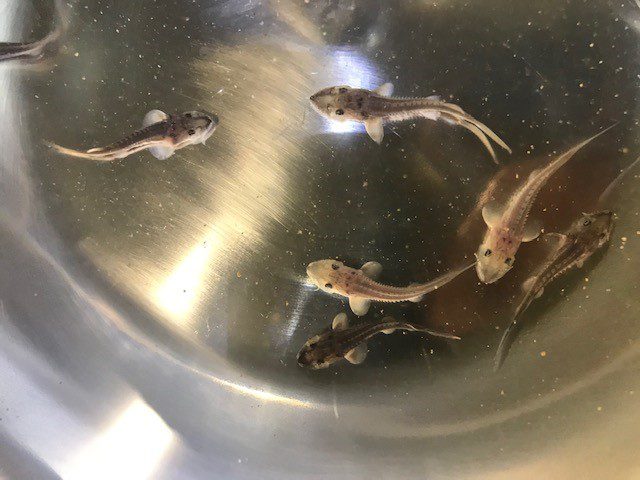
Repatriation reduces the potential of undesired genetic traits often associated with domestication. The approach results in many more parental lines in the released cohorts than in captive breeding approaches. Reducing artificial selection and the increased representation of parental lines in repatriated groups offers increased genetic variation and fitness resembling a wild cohort that is not possible with traditional captive breeding programs.
AT THE HATCHERY: FROM SPAWN TO STURGEON
During the spawning period, Idaho Power collects naturally spawned white sturgeon eggs from the river as they drift downstream. The collection is accomplished with specifically designed nets and mats that catch the eggs as they settle.
The eggs are taken to the hatchery where they are incubated for four to seven days until they hatch into tiny larvae that grow and start to feed. As they grow into young sturgeon, they are continually sorted by size to enhance their chances of survival.
Young sturgeon are kept at the facility for about one year and then returned back to the river to sustain populations in areas that lack sufficient natural production. This novel approach of using a hatchery to support higher survival of naturally spawned eggs has opened new doors for white sturgeon conservation. The young sturgeon returned to the river maintain the genetic diversity unique to Snake River white sturgeon.
After the Niagara Springs Hatchery was completed in early 2021, the first white sturgeon eggs were received at the hatchery that May. The hatchery’s numerous small circular tanks maintain the sturgeon’s different developmental stages and ages from hatch and hiding to feeding based on spawning event timing and accommodating the individual sturgeon’s variable growth.
The hatchery building houses a fish rearing area, wet lab, office/meeting area, egg receiving room, mechanical room, and attached dormitory. Within the rearing area are 30 circular fiberglass tanks (16 2-foot-diameter, 8 4-foot-diameter, and 6 8-foot diameter).
Eggs arriving at the hatchery are rinsed, inspected for fungus, counted, and placed in small volume upwelling incubators that are grouped by similar collection dates.
Once hatching begins, free embryos swim out of the incubators into a series of small circular tanks and begin to feed in 12-14 days. This transition onto feed is the most critical period for larval rearing with the greatest amount of labor during the sturgeon production period. A daily feeding regime of live and dry feeds is used to optimize survival and overall fish performance.
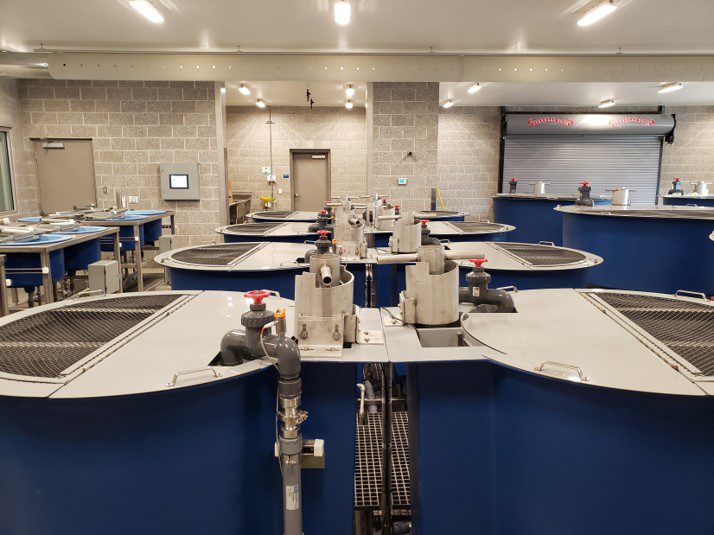
The fish are graded routinely throughout the rearing cycle to maintain proper feeding conditions and similar sizes to reduce competition and growth variability among tanks.
As larvae are established on artificial feed and achieve larger sizes, fish are then transferred into larger tanks (2-foot to 8-foot) to accommodate growth throughout the rearing cycle.
In the final preparation for stocking, juveniles are tagged, weighed, and sorted according to reach designation and release targets.
MEASURABLE RETURN
Transitioning from broodstock spawning to repatriation-based aquaculture has proven an astounding success, allowing Idaho Power and the Idaho Department of Fish and Game to rear and return up to 2,500 juvenile sturgeon to the river annually.
Idaho Power Company’s efforts have exceeded the 90% genetic diversity retention recommendations set forth by Idaho Power’s Snake River White Sturgeon Genetic Management Plan while also screening for abnormal ploidy (i.e., sets of chromosomes) at the facility, ensuring a genetically robust future population.
Idaho Power also plans to recapture and survey white sturgeon throughout the various reaches to monitor survival and growth rates, among others, to document the success of the program.









